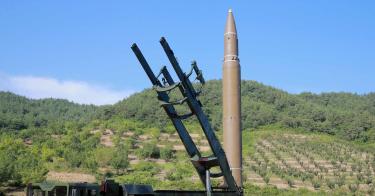An effective space-based sensor network is a critical component of the U.S. ballistic missile defense system. The better the data the missile defense system has, the more likely it is to successfully intercept incoming missiles. Data is the backbone of the ballistic missile defense architecture, and that is why investments in the sensor network are so critical.
The Missile Defense Agency, the Defense Department’s agency responsible for research, development, and acquisition of U.S. missile defense systems, relies primarily on the Space Tracking and Surveillance System for space-based sensors, and is currently developing the Space-based Kill Assessment network. The surveillance system provides “birth-to-death” tracking of ballistic missiles, including detecting both targets in early stages of a ballistic missile flight and midcourse reentry vehicles. The network is designed to provide a more accurate picture of whether a successful intercept actually occurred.
Space-based sensors “see” when hostile forces launch a ballistic missile. They then provide data used to calculate a fire-control solution, and guide missile defense interceptors to an intercept. The sensors help distinguish the real target from decoys, debris, and other objects in space. They work in tandem with U.S. ground- and sea-based sensors.
The advantage of space-based sensors is their persistence, range, and survivability compared to ground- or sea-based sensors. Russia and China are developing anti-satellite weapons, but shooting down a satellite is much more difficult than destroying ground- or sea-based radar.
Sensors provide U.S. missile defense interceptors with different types of data, including infrared signals, and X- and S-band radar signatures. The goal is to provide the interceptor with the most accurate and precise picture of the incoming ballistic missile and its warhead to maximize the probability of a successful intercept. A ballistic missile defense intercept is a feat of rocket science. Current U.S. interceptors use sheer force of impact, a hit-to-kill technology, to destroy the incoming missile closing at thousands of kilometers per hour.
One such successful intercept occurred at the end of May when the Ground-Based Midcourse Defense (GMD) missile interceptor shot down a target simulating an ICBM, the kind North Korea might use against U.S. territory. The system is currently the only system capable of shooting down long-range ballistic missiles.
Despite years of sanctions and a terrible state of its economy North Korea is vigorously working on perfecting its long-range missiles. Defense Secretary James Mattis has called North Korea “a direct threat to the United States.” However, Iran and other countries hostile to the United States or its allies, are also developing and deploying ballistic missiles. Thus, the general threat to the U.S. has increased.
Our current GMD system is designed to intercept less sophisticated ballistic missiles that do not have advanced countermeasures or decoys, and that are not deployed in large numbers.
It is not really capable of addressing the threat posed by the more sophisticated long-range ballistic missiles in the arsenals of China and Russia. We must to keep in mind that North Korean or Iranian programs will eventually reach the point where they possess more sophisticated ballistic missiles in larger quantities.
The United States can choose to be vulnerable. Or it can choose to protect and defend its institutions and way of life. In order to deal with more sophisticated ballistic missiles in larger quantities, the United States will need a comprehensive, multilayered ballistic missile defense architecture, which may include ballistic missile defense interceptors in space in addition to current systems that are ground and sea-based.
Today, we think about space as a place where intercepts occur and where we get some of our cueing and tracking data. Generally, for reasons mainly having to do with the legacy of Cold War thinking that deemed missile defense destabilizing, as well as technical and financial considerations, we do not think about space as a deployment site for missile defense interceptors. Some members of Congress, however, have begun to take the lead on changing this Cold War-era thinking and their advocacy is slowly making thinking about space-based missile defense more acceptable.
It is about time. Space-based missile defense would allow us to intercept a large number of sophisticated ballistic missiles, taking away the enormous coercive potential of an adversary’s ballistic missile arsenal. With space-based interceptors, ballistic missiles would be shot down earlier in their flight, giving us more time to engage ground-based (or sea-based) interceptors, should the first layer of defense fail. In early 1990s, we validated most technologies necessary for small, space-based interceptors. These technologies have since become substantially cheaper and better.
There is no doubt that the United States would be capable of deploying space-based missile defense. It’s time for the U.S. to think broadly about its ballistic missile defense requirements. The Pentagon’s ongoing Ballistic Missile Defense Review presents the perfect opportunity to do so.
This piece originally appeared in The Cipher Brief



